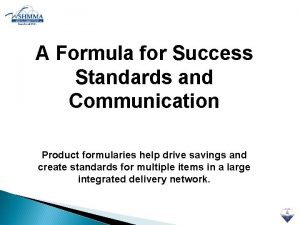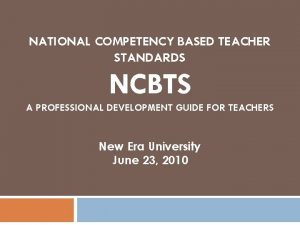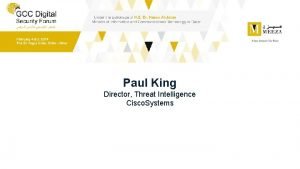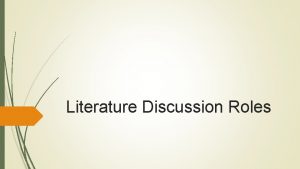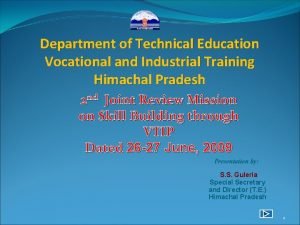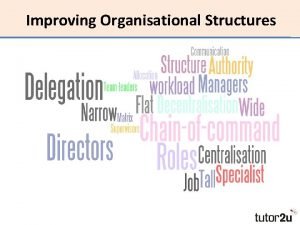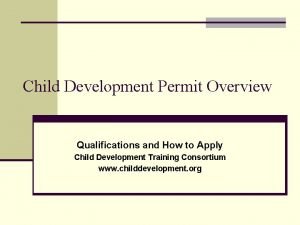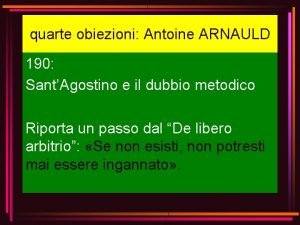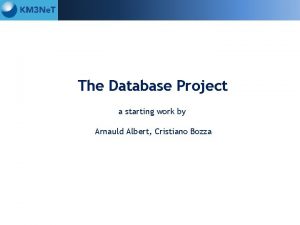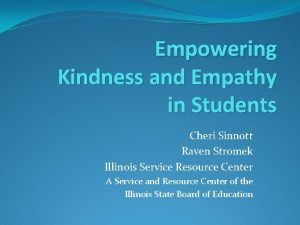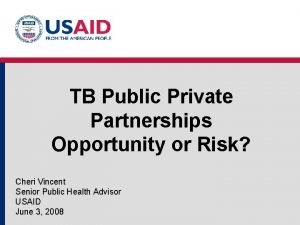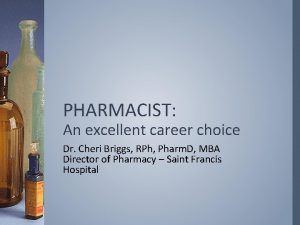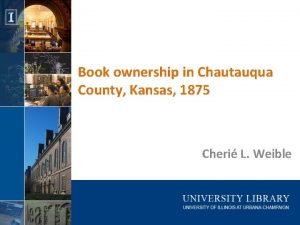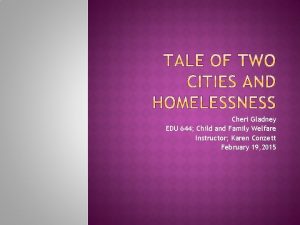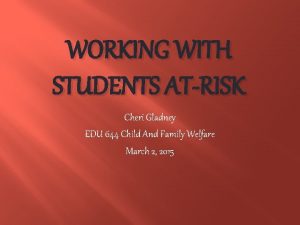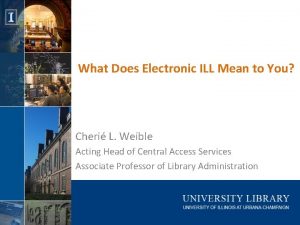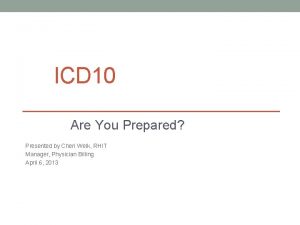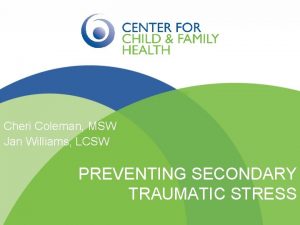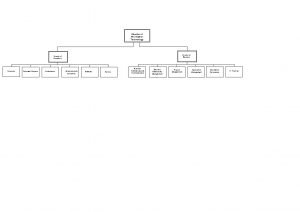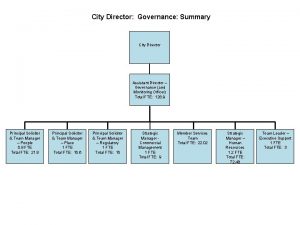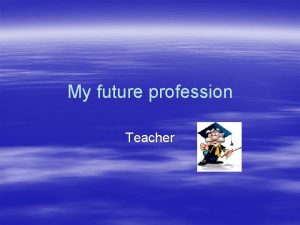Dr Cheri St Arnauld National Director for Teacher





















































































- Slides: 85


Dr. Cheri St. Arnauld National Director for Teacher Education Programs, Maricopa Community Colleges

Dr. Maria Harper-Marinick Vice Chancellor of Academic Affairs, Maricopa Community Colleges National CCTI Advisory Group Member

Dr. Rufus Glasper Chancellor, Maricopa Community Colleges and Co-Chair of the Governor’s P-20 Council

You are P-20

Governor’s P-20 Council The primary goal of the P-20 Council is to systematically address educational alignment in programs and policies from preschool, K-12, and postsecondary education into life-long learning opportunities.

What is P-20 doing?

Education Alignment Education/Workforce Pathways Communications Teacher Quality Data and Assessment Adolescent Literacy

What can you do?

Dr. Larry J. Warford National Project Director - League for Innovation in Community College’s CCTI National Project

IMPROVING STUDENT SUCCESS

Transitions – Why Critical Today “For most Americans, education and training through and beyond high school is now a necessary condition (not just the most advantageous or desirable route) for developing skills required by most well-paying jobs. ”

“While there has been much written about dropout from high school and student retention in college as separate phenomena, little conceptual or empirical work examines how the two fit together. ” Source: “Conceptualizing and Researching the Educational Pipeline Peter T. Ewell, Dennis P. Jones, and Patrick J. Kelly

Ewell, Jones, and Kelly suggest that this is timely for two major reasons: 1. Reforms are calling for improved transitions between high school and college in many states. (P-16) 2. Renewed interest in enhancing educational attainment as a key social asset.

“The whole future of our communities and our country, not to mention countless individuals, depends significantly on our [schools, colleges, and employers] ability to do a far better job of moving students to and through our institutions, toward better jobs and toward continuing education over a lifetime. ” Source: Dr. Kay Mc. Clenney, Director Community College Survey of Student Engagement, University of Texas

Transition Barriers • Students, parents, and K-12 educators get conflicting and vague messages about what students need to know to enter and succeed in college. (Bridge found that high school assessments often stress different knowledge and skills than do college entrance and placement requirements. ) The Bridge Project Stanford University

Transition Barriers • Coursework between high school and college is not connected. • Students graduate from high school under one set of standards and three months later are required to meet a whole new set of standards in college. The Bridge Project Stanford University

Transition Barriers • Current data systems are not equipped to address students’ needs across systems. • No one is held accountable for issues related to student transitions from high school to college. The Bridge Project Stanford University

Bridge Study Summary While educators and policymakers share the common goal of improving student performance, they often act in isolation; thus, efforts are sometimes conflicting or duplicated, and often certain needs are never addressed. The Bridge Project Stanford University

College and Career Transitions Initiative (CCTI) Cooperative Agreement between U. S. Department of Education Office of Vocational and Adult Education and The League for Innovation in the Community College Consortium

Purpose of CCTI will contribute to strengthening the role of community and technical colleges in • Easing student transitions between secondary and postsecondary education as well as transitions to employment, and • Improving academic performance at both the secondary and postsecondary levels.



CCTI Timeline November 2002 League awarded Cooperative Agreement with OVAE January 2003 RFP issued to all U. S. Community Colleges May 2003 Colleges selected

2005 -06 CCTI Site Partnerships 1 -Miami Dade College 6 -Corning Com. College 2 -Northern Virginia Com. College 7 -Maricopa Com. Colleges 3 -Ivy Tech Community College 8 -Anne Arundel Com. College 4 -Central Piedmont Com. College 9 -Lorain County Com. College 5 -SW Oregon Com. College 10 -Sinclair Com. College 5 11 -St. Louis Com. College 12 -Lehigh Carbon Com. College 13 -San Diego Com. College Dist. 14 -Prince George’s Com. College 15 -Fox Valley Technical College 15 6 3 11 13 7 9 10 12 2 4 1 8 14

CCTI Site Partnerships • Education & Training î Anne Arundel Community College (MD) î Lorain County Community College (OH) î Maricopa Community Colleges (AZ) • Health Science î Ivy Tech Community College (IN) î Miami Dade College (FL) î Northern Virginia Community College (VA) • Information Technology î Central Piedmont Community College (NC) î Corning Community College (NY) î Southwestern Oregon Community College (OR)

CCTI Site Partnerships • Law, Public Safety and Security î Fox Valley Technical College (WI) î Prince George’s Community College (MD) î San Diego Community College District (CA) • Science, Technology, Engineering and Mathematics î Lehigh Carbon Community College (PA) î Sinclair Community College (OH) î St. Louis Community College (MO)

OUTCOME #1 Decrease remediation at the postsecondary level

Percent of students who take remedial courses • 63% at two-year institutions • 40% at four-year institutions The Bridge Project Stanford University

OUTCOME #2 Increase enrollment and persistence in postsecondary education

National Statistics on High School Students • For every 100 ninth graders: AZ U. S. 59 67 Graduate from high school on time 30 38 Directly enter college 18 26 Still enrolled sophomore year 14 18 Graduate in 150% of time (2 - and 4 -year college)

OUTCOME #3 Increase academic and skill achievement at both the secondary and postsecondary levels

Rigor in High School “Knowing what they know today, a large majority of students say they would have worked harder and taken more difficult courses in high school. ” Source: “Rising to the Challenge: Are High School graduates prepared for college and work? ”; Achieve, Inc. , 2005

OUTCOME #4 Increase attainment of postsecondary degrees, certificates, or other recognized credentials

Why Focus on Student Retention? Student Pipeline Sources, 2000 High School Graduation Rate 67% Go to College Directly From High School 56% 2 Year College 4 Year College 30% 70% Return for Second Year of College 54% 74% Graduate With 2 Year Degree in 3 Years 30% Graduate With 4 Year Degree in 6 Years Data Sources: 53% NCES Common Core Data (2000); IPEDS Residency and Migration File (2000); ACT Institutional Survey (2001); NCES, IPEDS Graduation Rate Survey (2000).

OUTCOME #5 Increase successful entry into employment or further education

Are Students Prepared? • College instructors estimate that 42% of their students are not adequately prepared. • Employers estimate that 39% of high school graduates who have no further education are not prepared for their current job and that 45% are under prepared for advancement. Source: “Rising to the Challenge: Are High School graduates prepared for college and work? ”; Achieve, Inc. , 2005


Sixteen Career Clusters Agriculture, Food & Natural Resources Finance Architecture & Construction Education & Training Arts, AV Tech & Communications Government & Public Administration Business, Mgt & Admin. Health Science Hospitality & Tourism Manufacturing Human Services Marketing Sales & Services Information Technology Science, Tech, Engineering & Mathematics Law, Public Safety, Corrections & Security Transportation, Distribution & Logistics

Career Clusters Model careerclusters. org

CCTI Products · · · · Virtual Reader Career Pathway Templates Toolkit Case Studies Book National Policy Study State Policy Forums CCTI Website: www. league. org/ccti

Virtual Reader

CCTI Career Pathways Template Rigorous Academics CTE for all Dual Enrollment Early Assessment in H. S.


Toolkit Cover Page

Case Studies Book

National Policy Study Book

HSTW State Policy Report

What We Are Learning From CCTI • Community colleges can lead this work. • Partners are anxious to work together. • Communication is key: î generally among education sectors and business î between faculty of high school and college • Postsecondary remediation can be reduced. • Transformation needs to take place in the context of a P-20 or a lifetime framework.

CCTI Network www. league. org/ccti/networkapplication The Network Today: • 150 community colleges and their partners • 40 states and 2 Canadian provinces

The Beginning of a New Community College Movement Laurance J. Warford CCTI Project Director warford@league. org

“As one smart person has observed, our educational systems are perfectly designed to produce the results we are typically getting. “The kind of change that is required to accomplish more successful outcomes for many more students is not marginal change. It is transformational. It is change in the fundamental ways we do the business of education. It is change that requires strong leadership, relentless focus, and sustained effort over time. ” - Kay Mc. Clenney

Laurance J. Warford League for Innovation in the Community College warford@league. org

Questions?

Break

Scott Hess Branch Chief, Division of Academic-Technical Education, Office of Vocational and Adult Education (OVAE), US Department of Education

A Comparison of: “Programs of Study” as Defined in Perkins And “Clusters and Pathways” Defining Career and Technical Education

Perkins – “Programs of Study” “State approved programs, which may be adopted by local education agencies and postsecondary institutions to be offered as an option to students when planning for and completing future coursework, for career and technical content areas. ”

Programs of Study: • Incorporate secondary education and postsecondary education elements;

• Include coherent and rigorous content aligned with challenging academic standards and relevant career and technical content in a coordinated, non-duplicative progression of courses that align secondary education with postsecondary education to adequately prepare students to succeed in postsecondary education;

• May include the opportunity for secondary education students to participate in dual or concurrent enrollment programs or other ways to acquire postsecondary education credits; and

• Lead to an industry-recognized credential or certificate at the postsecondary level, or an associate or baccalaureate degree.

Two Major Projects Facilitated by OVAE • Career Clusters – Defines What… • College and Career Transitions Initiative (Pathways) – Suggests How…

CAREER CLUSTERS “An organizing tool defining CTE using 16 broad clusters of occupations and over 70 pathways with validated standards that ensure opportunities for all students regardless of their career goals and interests. ”

CAREER PATHWAYS “A career pathway is a coherent, articulated sequence of rigorous academic and career related courses, commencing in ninth grade and leading to an associate degree, and/or an industry-recognized certificate or licensure, and/or a baccalaureate and beyond. ”


Questions?

CCTI Case Study Panel Facilitated by Dr. Larry Warford

John Mulcahy CTE Director, Peoria Unified High School District

Julie Binnicker Education Professions Teacher, Cactus High School

Dr. Deborah Raffin Education Faculty, Estrella Mountain Community College

Clay Goodman Vice President for Occupational Education, Estrella Mountain Community College

Ray Ostos CCTI Project Cordinator, Maricopa Community Colleges

Question 1 There are many elements to your CCTI project. Within your project what has been the most beneficial to your institution and your students through this established partnership?

Question 2 How can your partnership strengthen career planning and transition services for students?

Question 3 What systems can support remediation or advanced postsecondary opportunities?

Question 4 What is the future of the partnership? Will it be expanded?

Closing comments

Questions?

Lunch and Networking

Barbara Border Interim Arizona Career and Technical Education Director, Arizona Department of Education

Group Work Exploring New Processes: Developing Career Pathways and Improving Student Transition through Partnerships

Question 1 What current partnerships do you have in place with community colleges or school districts? Question 2 What new partnerships or processes might be developed to build stronger pathways? Question 3 As an individual or an institution what specifically can you do to support students from high school to higher education? What will your possible steps?

Discussion Next Steps and Closing Comments

Thank You
 Cheri stephenson
Cheri stephenson Delaporte catcheur
Delaporte catcheur Cheri berri
Cheri berri Erf form
Erf form Good evening students
Good evening students Ncbts stands for
Ncbts stands for Ncbts domain 1
Ncbts domain 1 Expektans
Expektans Kyssande vind analys
Kyssande vind analys Boverket ka
Boverket ka Strategi för svensk viltförvaltning
Strategi för svensk viltförvaltning Ledningssystem för verksamhetsinformation
Ledningssystem för verksamhetsinformation Tack för att ni har lyssnat
Tack för att ni har lyssnat Returpilarna
Returpilarna Centrum för kunskap och säkerhet
Centrum för kunskap och säkerhet Läkarutlåtande för livränta
Läkarutlåtande för livränta Klassificeringsstruktur för kommunala verksamheter
Klassificeringsstruktur för kommunala verksamheter Påbyggnader för flakfordon
Påbyggnader för flakfordon Inköpsprocessen steg för steg
Inköpsprocessen steg för steg A gastrica
A gastrica Egg för emanuel
Egg för emanuel Hur räknar man standardavvikelse
Hur räknar man standardavvikelse Atmosfr
Atmosfr Var finns arvsanlagen
Var finns arvsanlagen Vilotidsbok
Vilotidsbok Rutin för avvikelsehantering
Rutin för avvikelsehantering Myndigheten för delaktighet
Myndigheten för delaktighet Presentera för publik crossboss
Presentera för publik crossboss Kontinuitetshantering
Kontinuitetshantering Tack för att ni lyssnade
Tack för att ni lyssnade Att skriva debattartikel
Att skriva debattartikel Kung som dog 1611
Kung som dog 1611 Tobinskatten för och nackdelar
Tobinskatten för och nackdelar Referatmarkeringar
Referatmarkeringar Varför kallas perioden 1918-1939 för mellankrigstiden
Varför kallas perioden 1918-1939 för mellankrigstiden Byggprocessen steg för steg
Byggprocessen steg för steg Karttecken sten
Karttecken sten Lufttryck formel
Lufttryck formel Rådet för byggkompetens
Rådet för byggkompetens Densitet vatten
Densitet vatten Elektronik för barn
Elektronik för barn Borra hål för knoppar
Borra hål för knoppar Tack för att ni har lyssnat
Tack för att ni har lyssnat Smärtskolan kunskap för livet
Smärtskolan kunskap för livet Typiska novell drag
Typiska novell drag Fimbrietratt
Fimbrietratt Trög för kemist
Trög för kemist Jiddisch
Jiddisch Enheter för massa
Enheter för massa Delegerande ledarskap
Delegerande ledarskap Indikation för kejsarsnitt på moderns önskan
Indikation för kejsarsnitt på moderns önskan Toppslätskivling dos
Toppslätskivling dos Redogör för vad psykologi är
Redogör för vad psykologi är Bris för vuxna
Bris för vuxna En lathund för arbete med kontinuitetshantering
En lathund för arbete med kontinuitetshantering Bra mat för unga idrottare
Bra mat för unga idrottare Gumman cirkel sång
Gumman cirkel sång Svenskt ramverk för digital samverkan
Svenskt ramverk för digital samverkan Etik och ledarskap etisk kod för chefer
Etik och ledarskap etisk kod för chefer Datorkunskap för nybörjare
Datorkunskap för nybörjare Klädsel i rom
Klädsel i rom Rita perspektiv
Rita perspektiv Ministerstyre för och nackdelar
Ministerstyre för och nackdelar Nationell inriktning för artificiell intelligens
Nationell inriktning för artificiell intelligens Bästa kameran för astrofoto
Bästa kameran för astrofoto Sju principer för tillitsbaserad styrning
Sju principer för tillitsbaserad styrning Plats för toran ark
Plats för toran ark Romarriket tidslinje
Romarriket tidslinje Bunden form dikt
Bunden form dikt Nyckelkompetenser för livslångt lärande
Nyckelkompetenser för livslångt lärande Gibbs reflekterande cykel
Gibbs reflekterande cykel Orubbliga rättigheter
Orubbliga rättigheter Matematisk modellering eksempel
Matematisk modellering eksempel Shaktismen
Shaktismen Bamse för de yngsta
Bamse för de yngsta Underlag för särskild löneskatt på pensionskostnader
Underlag för särskild löneskatt på pensionskostnader Verktyg för automatisering av utbetalningar
Verktyg för automatisering av utbetalningar National unification and the national state
National unification and the national state Nec managing director
Nec managing director Paul king cisco
Paul king cisco Discussion director
Discussion director Assistant director vicky
Assistant director vicky Director of technical education hp
Director of technical education hp Director or manager
Director or manager Child development matrix
Child development matrix Director hand signals
Director hand signals


